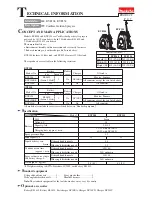
Model 2100 GW Plural
CoMPonent SPray Gun
General
The 2100 GW gun is a lightweight, hand-held, plural compo-
nent spray gun for spraying limited applications of two-compo-
nent materials, such as gel-coats or polyesters. The spray gun is
operated in the conventional manner. The trigger action starts,
and stops, the spray of both materials simultaneously. The two
materials exit separately as an atomized spray from their respec-
tive nozzles and impinge on each other approximately 6" in
front of the gun (resin) nozzle. Here, the resulting turbulence
insures intimate mixing.
The “base” resin is “cured” by addition of a curative (catalyst)
in a required ratio. In the 2100 GW gun, ratios of approximately
10:1 to perhaps 33:1 are possible by extending the curative with
a compatible diluent.
Preferably, the resin should be supplied from a pressure cup
mounted either on the gun or located remotely from it. In some
applications, a siphon cup may be acceptable.
The curative is supplied from a siphon container assembly (57)
mounted directly on the gun. Air, diverted from the gun handle,
passes through the air adjusting valve (39) to the nozzle body
(55) to provide the siphon action and to serve as atomizing air
for the curative. The adjustable fluid control (44) meters the
flow of curative.
SInce THe curATIve conTAIner IS A SIPHon
devIce ITS venT Hole muST AlWAyS be kePT oPen.
THe venT Hole IS locATed In THe cover AT THe
reAr (See IlluSTrATIon).
nozzle CharaCteristiCs and
spray patterns
The 2100 GW gun uses external atomizing nozzles* to produce
finer atomization and better control of the spray pattern. The
pattern can be changed from round to fan and to all intermedi-
ate shapes by adjusting the side port control (2) on the gun. The
pattern also can be rotated to any position in 360º by loosening
the retaining ring on the nozzle (12). Intimate intermixing and
distribution of the curative within the primary material is maxi-
mum when the long dimension of the fan spray pattern is verti-
cal (lined up with the gun handle).
The resin delivery rate of external atomizing nozzles is in the
low to medium range.
see “important adjustment note” page 2.
resin Volume output
resin output is controlled by two variables:
1. nozzle orifice size, air or resin.
2. Air and/or resin pressures.
Precise resin pressures can best be controlled by a fluid regula-
tor, tank, or pump pressure.
minute adjustments in flow can be made with the
control screw (17) which restricts the travel of the
resin needle (15).
CuratiVe Volume output
output of the curative is controlled by four variables:
1. curative nozzle orifice size.
2. Air adjustment control (39).
3. Adjustment of needle stem (44).
4. extending (diluting) the curative.
Volume rate of flow CalCulations
Resin: With atomizing air off and with resin pressure on,
dispense resin into a graduate or into a clean container (resin
can be reused) for 15 seconds. multiply this volume of resin by
four to determine volume rate of flow per minute. Increase or
decrease resin pressure as required to obtain desired volume rate
of flow.
CuRative: Turn off resin supply to gun. Fill the container
(45) with a measured amount of curative (a substitute fluid may
be used such as a solvent or water.) depress gun trigger and
spray until fluid starts to “spit”. check elapsed time and calcu-
late volume rate of flow per minute. repeat sampling, after
resetting air adjusting valve (39) and/or needle stem (44) to
obtain desired flow.
curative (residual less diluent) to resin volumetric ratio is
specified by the chemical manufacturer. With polyesters, for
example, the ratio usually is from 1/2 percent to a maximum of
approximately four percent. These ratios are based on theoreti-
cal requirements, and laboratory samples of about one pint
(500 cc) that cover minimum surface areas. However, spray
applications cover maximum surface areas. For this reason, and
because of loss of exothermic heat and, perhaps, some loss of
curative in overspray, it is suggested that spray samples be
made, and that optimum cure times be established by increase
or decrease in the volume of curative.
It should be noted that the air valve (9) is designed to open
slightly before the resin valve (15). The air valve also allows the
curative to flow before the resin does. For this reason, air
*Where atomization occurs entirely outside of the gun.
Continued on page 6
note
the curative and resin mix with each other outside of the
gun. purging of the gun and nozzles is not necessary as cata-
lyzed resin never enters the gun passages.
Replaces
Part Sheet
77-2936
part
sheet
77-2936r


























